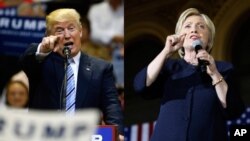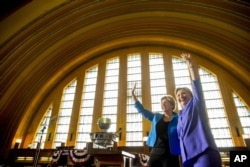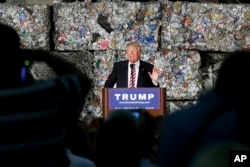It is one of the great unknowns about the 2016 presidential race.
How many Americans will walk into the voting booth on November 8 and mutter to themselves, 'Ugh, this is the choice I have, Clinton or Trump?'
It’s a scenario that gives hope to a Trump campaign down in the polls, and it is the stuff of nightmares for Democratic strategists who worry the only thing between Hillary Clinton and the White House is an unmovable core of voters who don't trust her.
At the moment Clinton would seem to hold some daunting advantages. Most recent polls show the former secretary of state with a steady lead over Donald Trump, on average five to six points, as both presumptive party nominees prepare for their party conventions next month.
Of particular concern to Republicans are some of the recent poll numbers showing 70 percent of women have a negative view of Trump, as well as his dismal ratings with non-white voters.
WATCH related video report
Clinton’s image problems
Clinton’s own ratings aren’t much better. The latest Quinnipiac University poll found Clinton with a very slight lead over Trump — 42 to 40 percent — with polls typically having a margin of error of 3-4 points.
Trump’s favorability ratings were only 34 percent positive, 57 percent negative. But Clinton wasn’t far behind with 37 percent approving and 57 percent disapproving.
“It would be difficult to imagine a less flattering from-the-gut reaction” to Trump and Clinton, said Tim Malloy, the assistant director of the Quinnipiac poll, in a statement on the survey. Malloy added that “voters find themselves in the middle of a mean-spirited, scorched earth campaign between two candidates they don’t like.”
Scorched earth is a good description of the campaign likely to come. Clinton teamed with Massachusetts Senator Elizabeth Warren at a rally in Ohio this week to go after Trump. Warren slammed Trump as a “small, insecure money-grubber who fights for nobody but himself.” Warren served as a warm-up act for Clinton.
“We are not going to let Donald Trump bankrupt America the way he bankrupted his casinos!” Clinton said to cheers at a rally in Cincinnati.
At a speech later that same day in Chicago, though, Clinton made a rare acknowledgment of her own polling problems and the challenge facing her to win back voter trust before November.
“And I personally know I have work to do on this front,” Clinton said. “A lot of people tell pollsters they don’t trust me. Now, I don’t like hearing that. And it certainly is true I’ve made mistakes. I don’t know anyone who hasn’t. So I understand people having questions.”
Trump has a higher hill to climb
That being said, most analysts believe Clinton’s challenges pale in comparison to those facing Trump, who is held in very low esteem by women and minority voters. The polls on Trump have Republican Party leaders worried but hopeful that the New York billionaire still has time to turn things around.
Trump insists he’ll win because voters see him as the ultimate political outsider.
“As soon as I ran, I became an insurgent. I became an outsider. Guys who were my friends said, ‘you’re an outsider!’ And you know why? Because I am going to do what is right for you. I am not going to do what is right for them!” Trump told supporters at a recent rally in Phoenix.
Senate Republican leader Mitch McConnell remains hopeful Trump can turn his image around.
“I think there is no question he has made a number of mistakes over the last few weeks,” McConnell told ABC’s “This Week.” “I think they are beginning to right the ship and it’s a long time until November.”
Trump has started to use a teleprompter for some of his speeches now, something for which he used to bash Clinton. And at times, Trump seems like a more disciplined candidate.
Many analysts still see him struggling, however, to shift from a primary contender, eager to win over conservatives, to a general election candidate hoping to broaden his appeal.
“I’ve always thought that some of Mr. Trump’s rhetoric works very well for [Republican] primary audiences, but it is going to cause him a larger problem, potentially, in the fall,” said longtime analyst Tom DeFrank of National Journal on VOA’s “Issues in the News.”
Clinton has work to do
But Republican strategists warn that Hillary Clinton’s negative poll numbers also are cause for concern for Democrats, and that Clinton has some work to do before November.
“Independent of all of her baggage, she is a miserable candidate,” said Republican analyst Scot Faulkner. “She’s a poor speaker. She does not relate well to people. They are reintroducing her [so many times] so it is like, Hillary 7.0.”
Faulkner is one Republican who believes Trump can overcome his negative baggage and go on to victory in November, primarily because of Clinton’s weaknesses with voters.
There is little doubt that Clinton will focus on Trump’s negatives to boost Democratic voter turnout in November, according to John Fortier with the Bipartisan Policy Center in Washington.
“She is so well known in politics that many people already don’t like her and have already formed opinions. And so for Hillary Clinton the challenge really is to be able to turn out her base, to show people that Donald Trump is not the alternative they want,” said Fortier.
But Clinton could have a tough time matching the Democratic turnout effort that won two elections for Barack Obama.
“They will try to get Hispanics registered to turnout. They will try to get African American turnout to be what it was when Obama was running. They will try to get young people to turn out and vote. But it’s a challenge,” said Gallup pollster Frank Newport.
Newport adds that one of the great wild cards of this election is the demand for change and how that will play out for Americans confronted with the choice of either Clinton or Trump.
“The public is very, very disgusted, and I would use that word with the way Congress in Washington operates — the bickering, the lack of compromise, sticking to principle rather than be willing to compromise. Americans don’t like that at all.”
Newport sees the election coming down to which side can do a better job of turning out its supporters. With both candidates saddled with negative approval ratings, though, predicting who wins a “lesser of two evils” election has become a major challenge for the pollsters and pundits alike.



















